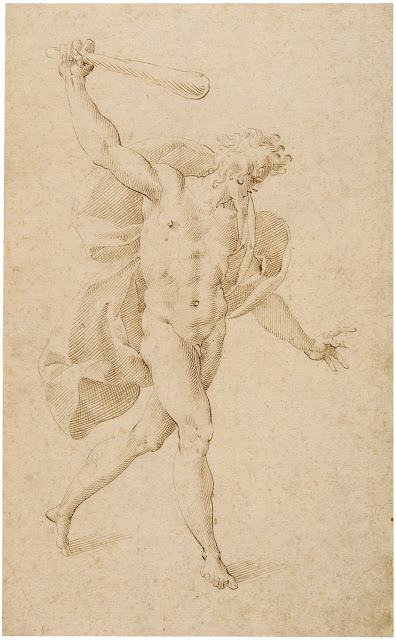 |
| Annibale Carracci Youth pulling on sock ca. 1585-90 drawing British Museum |
 |
| Annibale Carracci Youth with lantern ca. 1585 drawing British Museum |
 |
| Annibale Carracci Angel playing violin ca. 1585 drawing British Museum |
 |
| Annibale Carracci Study after Correggio 16th century drawing British Museum |
The three famous Carracci from Bologna (Annibale, Lodovico & Agostino) received wide praise all across Italy toward the end of the 16th century. They had bravely departed from the nefarious mainstream path of Mannerist exaggeration and "restored art" by turning back to nature (as in the drawing at top, where the darned sock thrust toward the viewer represents nature). At exactly the same time Caravaggio also was credited with "restoring art" by turning back to nature (the notorious bare peasant feet in Caravaggio's paintings corresponding with great neatness to the darned sock of Annibale). Both Caravaggio and the Carracci engendered separate schools of followers who continued faithfully reproducing the style-mannerisms of their founding masters throughout the 17th century. Until eventually somebody reformed them.
 |
| Annibale Carracci Landscape with Jacob sleeping 16th century drawing Metropolitan Museum |
 |
| Annibale Carracci Adoration of the Shepherds ca. 1606 etching, engraving British Museum |
The Adoration of the Shepherds (above) is built in a surprising way around the tree-trunk pillar that holds up the roof of the stable. This pillar is planted in the utmost foreground all on its own, tenderly depicted with three-dimensional grain, and allowed to cut the picture into two separate units. Four large shepherds more than fill the narrow space on the left. Contained on the far side of the pillar, they are also confined behind a diagonal bank that runs from lower right to upper left. The manger scene – on the larger, right-hand side – appears flattened against the stable wall, like a two-dimensional frieze. There is a vacant block of air in front of it. The radically foreshortened infant is like an emblem on a coin. When the eye drifts back to the shepherds, their physical proximity has increased. They are the picture's protagonists, not the faraway actors in the pageant of the miraculous birth. And the tree-trunk pillar turns out to be the self-assertion of the here-and-now.
 |
| Lodovico Carracci Oarsman from behind 1590s drawing British Museum |
 |
| follower of Lodovico Carracci Figure study, rear view 16th century drawing Prado |
 |
| follower of Lodovico Carracci Figure study, front view 16th century drawing Prado |
 |
| Agostino Carracci Portrait of Giovanni Gabrielli, called 'Il Sivello' ca. 1599 engraving British Museum |
"The actor seen half-length, leaning on a ledge, and holding a theatrical mask," according to the catalog description. Giovanni Gabrielli was famous in the world of commedia dell'arte. He belonged to the same generation as many of Shakespeare's actors and Shakespeare himself, though the cultural gap between Italy and England was wide enough. Gabrielli's motto, as engraved on the plate, expressed his uniqueness, SOLUS INSTAR OMNIUM [alone, he equals all of them]. The actor's specialty was voices, foreigner's voices, women's voices, every state and condition of voice. "He would perform all the play alone, changing costume and voice, on and off stage." At least two generations of Il Sivello's descendants went on to similar success.
 |
| Agostino Carracci Preparatory drawing for 'Il Sivello' engraving ca. 1599 Chatsworth House, Derbyshire |
 |
| Agostino Carracci The Three Graces ca. 1590-95 engraving British Museum |
 |
| Agostino Carracci Sheet of studies 16th century drawing British Museum |
 |
| Agostino Carracci Christ and the woman at the well 1593-94 drawing British Museum |
The image below would NOT have been chosen as an example by those who believed the Carracci were leading the way back to nature. Curators at the British Museum believe this engraved headdress of plumes and scrolls and oval plaques would have been purchased – at least in some cases – for actual use, cut out and mounted to a stiff backing, probably then decorated with colors and attached to the head, perhaps as part of a carnival costume. The extra plaque-motifs supplied in the margin allowed for a selection of goddess-portraits and corresponding mythologies.
 |
| Agostino Carracci Headpiece with plumes 1590s engraving British Museum |